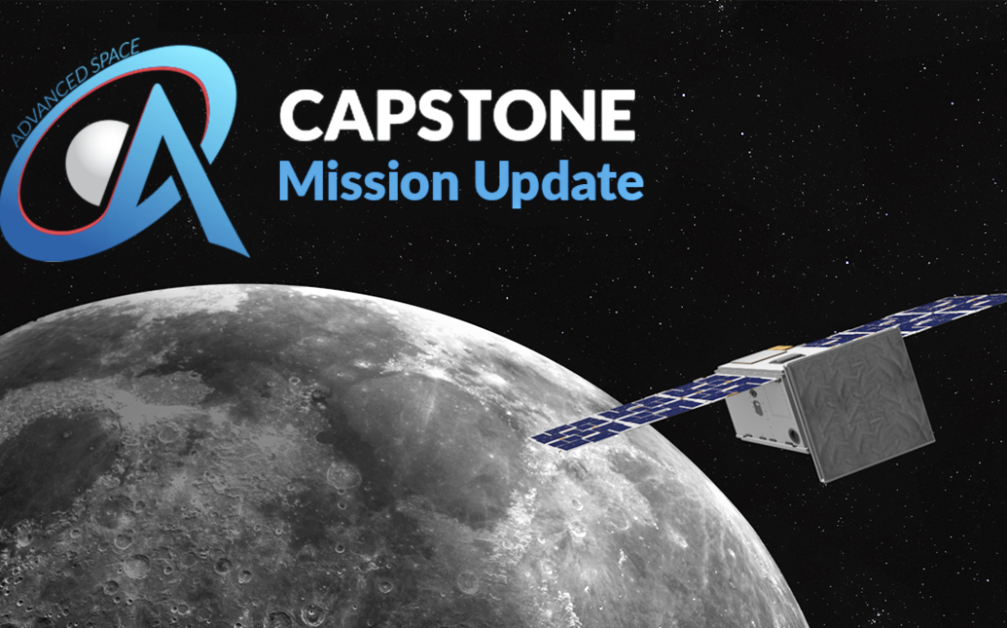
Advanced Space LLC. has completed its fourth trajectory correction maneuver (TCM) for CAPSTONE — TCM-4 was the fourth of six planned maneuvers en route to the Moon, targeting the precise orbit for the CAPSTONE demonstration. This follows the restoration of the spacecraft’s capabilities as it has recovered from the anomaly that occurred after TCM-3. CAPSTONE is just two weeks away as of this writing from arrival at the Moon.

The Cislunar Autonomous Positioning System Technology Operations and Navigation Experiment, CAPSTONE, spacecraft mission will test the lunar Near Rectilinear Halo Orbit (NRHO) that is the intended orbit for Gateway, a lunar space station that will support NASA’s Artemis program, making CAPSTONE the first milestone launch of the Artemis program.

The primary mission is planned for at least six months of operations orbiting the Moon, with enhanced mission opportunities in the following 12 months. CAPSTONE has already contributed insights with shared navigation and operational data to the Artemis I rideshare payloads that will assist them in their mission operations.
Recently, the Deep Space Network (DSN) performed a test with NASA’s Lunar Reconnaissance Orbiter (LRO) to confirm that LRO could receive and return the signal CAPSTONE will be using to interact with the spacecraft as part of the CAPS software demonstrations once it arrives at the Moon.

CAPSTONE launched on June 28th and is a 12U, 55-pound cubesat built by Terran Orbital. Using a fuel-efficient, Ballistic Lunar Transfer (BLT) method, CAPSTONE’s journey from launch to lunar orbit is a total of four months. A key feature of the BLT is that the mission operations and commissioning have the time during transit to evaluate performance and complete thorough check-out of systems before arriving at the Moon. As expected, the cruise thus far has focused on preparing the spacecraft for its mission at the Moon.
“The CAPSTONE team at Advanced Space, Terran Orbital, and their partners has shown great resilience over the past several weeks. Now, as CAPSTONE approaches lunar orbit, we are looking forward to getting into more of the technology demonstrations that are part of this mission and gathering operational data with the spacecraft in orbit at the Moon,” said Christopher Baker, program executive for the Small Spacecraft Technology program in NASA’s Space Technology Mission Directorate. “CAPSTONE is a great example of the work we can do with our commercial partners, small businesses, and small spacecraft.“
“This TCM confirms the preparation, extensive analysis, teams working together and continued hard work to allow this mission to remain successful, especially following the recent anomaly,” said Alec Forsman, Systems Engineering Lead and Mission Operations Manager for CAPSTONE at Advanced Space. “Every activity provides many lessons learned before our arrival at the Moon. These experiences better prepare the team for lunar operations.”
Some numbers from the TCM include:
• Maneuver telemetry shows that the spacecraft propulsion system fired for the nominal duration of approximately 220 seconds.
• At the time of maneuver execution, the spacecraft was approximately 308,076 miles or 495,800 km from the Earth (~14 times further than the GEO belt and ~69,200 miles or 111,400 km further than the Moon).
• CAPSTONE has been flying solo in space for more than 100 days (125 days since launch, 119 days since separation).
A primary mission objective is to demonstrate autonomous spacecraft-to-spacecraft navigation services that will allow future spacecraft to determine their location in space without relying exclusively on tracking from Earth. This technology was developed by Advanced Space and is called CAPS™, the Cislunar Autonomous Positioning System.
“What is amazing about this team at Advanced Space is how they execute. CAPSTONE is one of the many important projects that we have delivered successfully to our customers,” said Tom Gardner, Director of Engineering and Program Manager for CAPSTONE. “We have the great fortune of working with interplanetary projects to Mars and other planets, on AI in space, XGEO Awareness, and other novel space technologies. Each team member ensures success with them all and the interdependencies become a benefit to our customers and our industry as a whole.”
